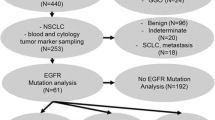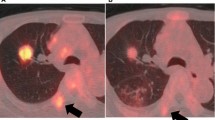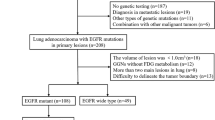Objective
The FDG uptake in lung cancer is considered to reflect the degree of malignancy, while alterations of some tumor suppressor genes are considered to be related to the malignant biological behavior of tumors. The aim of this study is to examine the relationship between FDG-PET and alterations in the tumor suppression genes of lung cancer.Methods: We examined 28 patients with primary lung cancer who underwent FDG-PET before surgery consisting of 17 patients with adenocarcinoma, 10 with squamous cell carcinoma and 1 with large cell carcinoma. The FDG-PET findings were evaluated based on the standardized uptake value (SUV). Alterations in the tumor suppressor genes, Rb, p16, p27 and p53, were evaluated immunohistochemically.Results: The FDG uptake in lung cancer with alteration in each tumor suppressor gene tended to be higher than in those genes without alterations, although the differences were not significant. In 15 tumors with alterations in either tumor suppressor genes, the FDG uptake was 6.83 ± 3.21. On the other hand, the mean FDG uptake was 1.95 in 2 tumors without alterations in any genes. The difference in the FDG uptake between the 2 groups was statistically significant (p<0.001).Conclusions: In conclusion, the presence of abnormalities in the tumor suppressor genes, which results in an accelerated cell proliferation, is thus considered to increase the FDG uptake in lung cancer.
Similar content being viewed by others
References
Di Chiro G, DeLaPaz RL, Brooks RA, Sokoloff L, Komblith PL, Smith BH, et al. Glucose utilization of cerebral gliomas measured by [18F]fluorodeoxyglucose and positron emission tomography.Neurology 1982; 32: 1323–1329.
Leskinen-Kallio S, Ruotsalainen U, Någren K, Teräs M, Joensuu H. Uptake of carbon-11-methionine and fluorodeoxyglucose in non-Hodgkin’s lymphoma: a PET study.J Nucl Med 1991; 32: 121–128.
Higashi K, Ueda Y, Seki H. F-18 FDG PET imaging is negative in bronchioloalveolar lung carcinoma.J Nucl Med 1998; 39: 1016–1020.
Vesselle H, Schmidt RA, Pugsley JM, Li M, Kohlmyer SG, Vallières E, et al. Lung cancer proliferation correlates with [F-18]fluorodeoxyglucose uptake by positron emission tomography.Clin Cancer Res 2000; 6: 3837–3844.
Higashi K, Ueda Y, Ayabe K, Sakurai A, Seki H, Nambu Y, et al. FDG PET in the evaluation of the aggressiveness of pulmonary adenocarcinoma: correlation with histopathological features.Nucl Med Commun 2000; 21: 707–714.
Duhaylongsod FG, Lowe VJ, Ratz EF, Vaughn AL, Coleman RE, Wolfe WG. Lung tumor growth correlations with glucose metabolism measured by fluoride-18 fluorodeoxyglucose positron emission tomography.Ann Thorac Surg 1995; 60: 1348–1362.
Higashi K, Ueda Y, Yagishita M. FDG PET measurement of the proliferative potential of non-small cell lung cancer.J Nucl Med 2000; 41: 85–92.
Xu HJ, Quinlan DC, Davidson AG, Hu SX, Summers CL, Li J, et al. Altered retinoblastoma protein expression and prognosis in early-stage non-small cell lung carcinoma.J Natl Cancer Inst 1994; 86: 695–699.
Tomizawa Y, Kohno T, Fujita T, Kiyama M, Saito R, Noguchi M, et al. Correlation between the status of the p53 gene and survival in patients with stage I non-small cell lung carcinoma.Oncogene 1999; 18: 1007–1014.
Catzavelos C, Tsao MS, DeBoer G, Bhattacharya N, Shepherd FA, Slingerland JM. Reduced expression of the cell cycle inhibitor p27Kip1 in non-small cell lung carcinoma: a prognostic factor independent of Ras.Cancer Res 1999; 59: 684–688.
Tsukamoto S, Sugio K, Sakada T, Ushijima C, Yamazaki K, Sugimachi K. Reduced expression of cell-cycle regulator p27Kip1 correlates with a shortened survival in non-small cell lung cancer.Lung Cancer 2001; 34: 83–90.
Ng CS, Zhang J, Wan S, Lee TW, Arifi AA, Mok T, et al. Tumor p16M is a possible marker of advanced stage in non-small cell lung cancer.J Surg Oncol 2002; 79: 101–106.
Sugio K, Tsukamoto S, Ushijima C, Yamazaki K, Kase S, Yamaguchi M, et al. Clinical significance of the Rb expression in adenocarcinoma of the lung.Anticancer Research 2001; 21: 1931–1936.
Koga T, Hashimoto S, Sugio K, Yoshino I, Nakagawa K, Yonemitsu Y, et al. Heterogeneous distribution of p53 immunoreactivity in human lung adenocarcinoma correlates with MDM2 protein expression, rather than with p53 gene mutation.Int. J Cancer (Pred Oncol) 2001; 95: 232–239.
Mishina T, Dosaka-Akita H, Kinoshita I, Hommura F, Morikawa T, Katoh H, et al. Cyclin D1 expression in non-small cell lung cancers: its association with altered p53 expression, cell proliferation and clinical out come.Br J Cancer 1999; 80: 1289–1295.
Xu HJ, Hu SX, Cagle PT, Moore GE, Benedict WF. Absence of retinoblastoma protein expression in primary non-small cell lung carcinomas.Cancer Res 1991; 51: 2735–2739.
Reissmann PT, Koga H, Takahashi R, Figlin RA, Holmes EC, Piantadosi S, et al. Inactivation of the retinoblastoma susceptibility gene in non-small cell lung cancer. The Lung Cancer Study Group.Oncogene 1993; 8: 1913–1919.
Dosaka-Akita H, Hu SX, Fujino M, Harada M, Kinoshita I, Hu HJ, et al. Altered retinoblastoma protein expression in non-small cell lung carcinoma: its synergistic effects with altered ras and p53 protein status on prognosis.Cancer 1997; 79: 1329–1337.
Brambilla E, Gazzeri S, Lantuejoul S, Coll JL, Moro D, Negoescu A, et al. p53 mutant immunophenotype and deregulation of p53 transcription pathway (Bcl2, Bax, and Waf1) in precursor bronchial lesions of lung cancer.Clin Cancer Res 1998; 4: 1609–1618.
Brambilla E, Gazzeri S, Moro D, Lantuejoul S, Veyrenc S, Brambilla C. Alterations of Rb pathway (Rb-p16INK4-cyclin D1) in preinvasive bronchial lesions.Clin Cancer Res 1999; 5: 243–250.
Kawasaki M, Noguchi M, Morikawa A, Matsuno Y, Yamada T, Hirohashi S, et al. Nuclear p53 accumulation by small-sized adenocarcinomas of the lung.Pathol Int 1996; 46: 486–490.
Passlick B, Izbicki JR, Haussinger K, Thetter O, Pantel K. Immunohistochemical detection of p53 protein is not associated with a prognosis in non-small cell lung cancer.J Thorac Cardiovasc Surg 1995; 109: 1205–1211.
Huang C-I, Taki T, Higashiyama M, Kohno N, Riyake M. p16 protein expression is associated with a poor prognosis in squamous cell carcinoma of the lung.Br J Cancer 2000; 82: 374–380.
Gould MK, Maclean CC, Kuschner WG, Rydzak CE, Owens DK. Accuracy of positron emission tomography for diagnosis of pulmonary nodules and mass lesion: a meta-analysis.JAMA 2001; 285: 914–924.
Sasaki M, Kuwabara Y, Yoshida T, Nakagawa M, Koga H, Hayashi K, et al. Comparison of MET-PET and FDG-PET for differentiation between benign lesions and malignant tumors of the lung.Ann Nucl Med 2001; 15: 425–431.
Sasaki M, Ichiya Y, Kuwabara Y, Akashi Y, Yoshida T, Fukumura T, et al. The usefulness of FDG positron emission tomography for the detection of mediastinal lymph node metastases in patients with non-small cell lung cancer: a comparative study with X-ray computed tomography.Eur J Nucl Med 1996; 23: 741–747.
Dwamena BA, Sonnad SS, Angobaldo JO, Wahl RL. Metastases from non-small cell lung cancer: mediastinal staging in the 1990s—meta-analytic comparison of PET and CT.Radiology 1999; 213: 530–536.
Marom EM, McAdams HP, Erasmus JJ, Goodman PC, Culhane DK, Coleman RE, et al. Staging non-small cell lung cancer with whole-body PET.Radiology 1999; 212: 803–809.
Vansteenkiste JF, Stroobants SG, Dupont PJ, De Leyn PR, Verbeken EK, Deneffe GJ, et al. Prognostic importance of the standardized uptake value on18F-fluoro-2-deoxy-glucose-positron emission tomography scan in non-small cell lung cancer: an analysis of 125 cases.J Clin Oncol 1999; 17: 3201–3206.
Kubota R, Kubota K, Yamada S, Tada Y, Ido T, Tamahashi N. Microautoradiographic study for the differentiation of intratumoral macrophages, granulation tissues and cancer cells by the dynamics of fluorine-18-fluorodeoxyglucose uptake.J Nucl Med 1994; 35: 104–112.
Minn H, Clavo AC, Grénman R, Wahl RL.In vitro comparison of cell proliferation kinetics and uptake of tritiated fluorodeoxyglucose andl-methionine in squamous-cell carcinoma of the head and neck.J Nucl Med 1995; 36: 252–258.
Haberkorn U, Strauss LG, Reisser C, Haag D, Dimitrakopoulou A, Ziegler S, et al. Glucose uptake, perfusion, and cell proliferation in head and neck tumors: relationship of positron emission tomography to flow cytometry.J Nucl Med 1991; 32: 1548–1555.
Okada J, Yoshikawa K, Itami M, Imaseki K, Uno K, Itami J, et al. Positron emission tomography using fluorine-18-fluorodeoxyglucose in malignant lymphoma: a comparison with proliferative activity.J Nucl Med 1992; 33: 325–329.
Avril N, Menzel M, Dose J, Schelling M, Weber W, Jänicke F, et al. Glucose metabolism of breast cancer assessed by18F-FDG PET: histologic and immunohistochemical tissue analysis.J Nucl Med 2001; 42: 9–16.
Jacob R, Welkoborsky HJ, Mann WJ, Jauch M, Amedee R. [Fluorine-18]fluoro-deoxyglucose positron emission tomography, DNA ploidity and growth fraction in squamous-cell carcinomas of the head and neck.ORL Otorhinolaryngol Relat Spec 2001; 63: 307–313.
Higashi K, Clavo AC, Wahl RL. Does FDG uptake measure proliferative activity of human cancer cells?In vitro comparison with DNA flow cytometry and tritiated thymidine uptake.J Nucl Med 1993; 34: 414–419.
Haberkorn U, Ziegler SI, Oberdorfer F, Trojan H, Haag D, Peschke P, et al. FDG uptake, tumor proliferation and expression of glycolysis associated genes in animal tumor models.Nucl Med Biol 1994; 21: 827–834.
Minn H, Lapela M, Klemi PJ, Grénman R, Leskinen S, Lindholm P, et al. Prediction of survival with fluorine-18-fluoro-deoxyglucose and PET in head and neck cancer.J Nucl Med 1997; 38: 1907–1911.
Buck AC, Schirrmeister HH, Guhlmann C-A, Diederichs CG, Shen C, Buchmann I, et al. Ki-67 immunostaining in pancreas cancer and chronic active pancreatitis: Doesin vivo FDG uptake correlate with proliferative activity?J Nucl Med 2001; 42: 721–725.
Akashi Y, Kuwabara Y, Ichiya Y, Sasaki M, Yoshida T, Fukumura T, et al. The partial volume effect correction for pulmonary mass lesions using a68Ga/68Ge transmission scan in PET study.KAKU IGAKU (Jpn J Nucl Med) 1994; 31: 1511–1517. (in Japanese)
Author information
Authors and Affiliations
Corresponding author
Rights and permissions
About this article
Cite this article
Sasaki, M., Sugio, K., Juwabara, Y. et al. Alterations of tumor suppressor genes (Rb, p16, p27 and p53) and an increased FDG uptake in lung cancer. Ann Nucl Med 17, 189–196 (2003). https://doi.org/10.1007/BF02990021
Received:
Accepted:
Issue Date:
DOI: https://doi.org/10.1007/BF02990021




